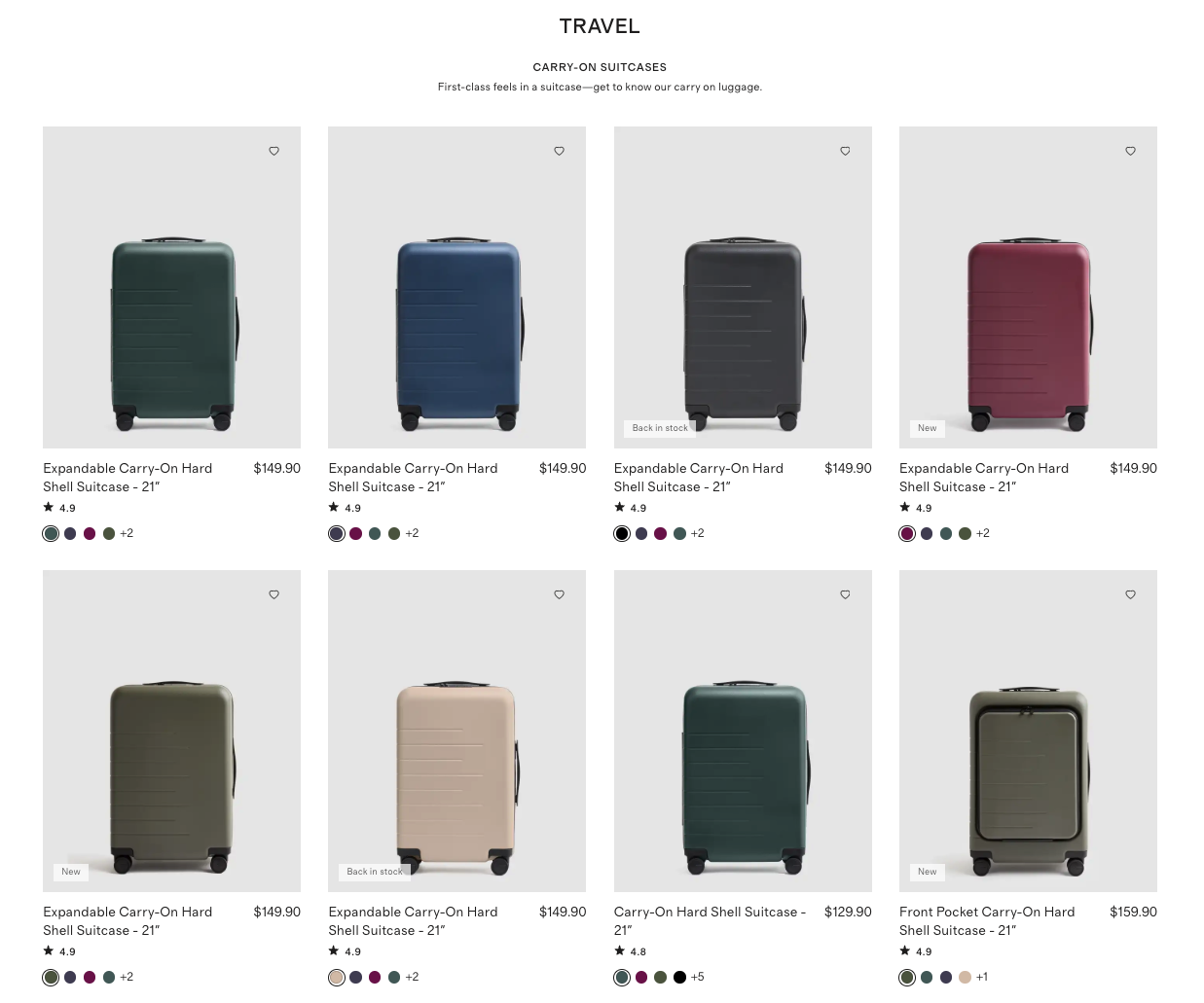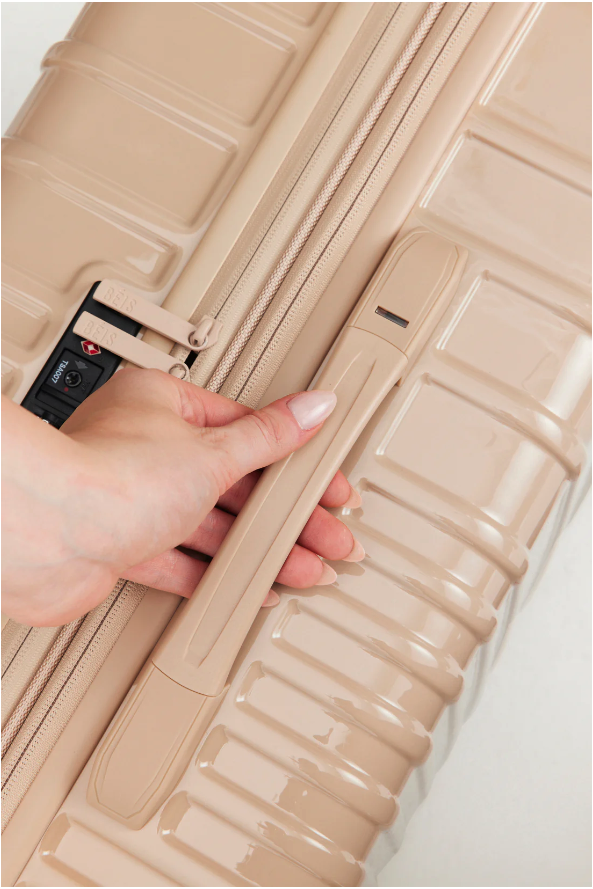DTC Luggage Disruption

Introduction
The luggage market has long been dominated by established players like Samsonite, Tumi, and Briggs & Riley, brands that have traditionally relied on brick-and-mortar retail.
In 2016, Away launched its affordable luggage line and disrupted the market with its DTC offering which quickly gained popularity. Since then, newer DTC entrants like Beis, Solgaard, Monos, July, and Dagne Dover have capitalized on the post-pandemic surge in travel demand, offering stylish and competitively priced products that resonate with a new generation of travelers.
While these new players are capturing market share, Particl has also observed increased consumer spending on luxury travel products (i.e., suitcases over $500), indicating a greater appetite for travel spending overall.
The uptick in travel is supported by rising passport issuance, with the U.S. State Department reporting that 2023 broke the record for most passports issued in a calendar year—a clear indicator of renewed interest in international travel. As a result, these DTC brands are not only responding to this increased demand but are also redefining consumer expectations with innovative features and direct-to-doorstep convenience, challenging the dominance of traditional retail giants.
The global luggage market took a significant hit in 2020, but it is expected to reach pre-pandemic norms by the end of 2024; the market has grown roughly 10% annually since 2020.
Luggage Market
Market Size in USD Bn from 2019 to 2025
Data from Statista suggests that the share of spend on luxury products is increasing in the luggage market.
Share of Luggage Sales: Luxury vs. Non-Luxury
Share (%) of total luggage sales change over time; luxury increasing noticeably since 2017
How fast is DTC luggage growing?
As more consumers shift to online shopping for travel gear, the direct-to-consumer (DTC) luggage market – which we will consider synonymous with online for the purposes of this analysis – is gaining a significant share of sales within the overall luggage industry.
DTC/Online vs Traditional Retail Luggage Sales
Share (%) of DTC/Online luggage sales increasing over time
While the broader market has seen a steady recovery post-pandemic, the DTC segment has been growing at an accelerated rate as more consumers shift toward online shopping for travel gear.
Brands like Briggs & Riley have adapted to this trend, reporting significant growth in their online sales (nearly 150% in 2 years), signaling their pivot toward a stronger DTC presence.
Briggs & Riley Monthly Online Luggage Sales (Normalized)
Online sales volume from November 2022 to September 2024
Meanwhile, Monos has experienced remarkable expansion (almost 300% YoY growth), with rapid sales growth observed in 2023.
Monos Monthly Online Sales Volume (Normalized)
Sales volume from November 2022 to March 2024
As more consumers embrace the convenience, competitive pricing, and product innovation offered by DTC brands, this segment is capturing an increasing share of the market, leaving traditional retail-focused brands (e.g., Samsonite, Tumi) to adjust to this evolving landscape.
In summary, Particl has observed that leading DTC luggage brands are experiencing over 100% year-over-year sales growth. In contrast, we project the overall DTC luggage market to grow at 20% annually, double the broader market growth rate of 10%.
Who is launching luggage lines?
The expansion of the luggage market has attracted a variety of non-traditional players, many of whom are capitalizing on their existing brand equity to introduce luggage and travel gear.
Notable examples include Ridge Wallets, which recently launched a new line of luggage following its success in minimalist wallets. Similarly, Quince, known for its direct-to-consumer model focused on high-quality essentials, has introduced a range of travel bags and luggage at competitive price points, appealing to budget-conscious yet style-focused consumers.
The Ridge Wallet has seen impressive sales growth of its line of suitcases over the last ~12 months.
The Ridge Wallet Online Suitcase Sales (Normalized)
Sales volume from November 2023 to September 2024
Quince launched its luggage line in early 2023 at an incredibly affordable price (~$100-200) relative to similar players (average market price ~$350 for a carry-on).

In addition to these newer entrants, established brands outside of the traditional luggage space are increasing their presence. Patagonia, for instance, has seen growing sales of travel gear, particularly its durable and eco-friendly Black hole Duffel bags, which appeal to environmentally conscious consumers. Other notable launches include outdoor brands like YETI, which has ventured into hard-sided luggage, and Herschel Supply Co., which expanded from backpacks to include a more extensive line of travel gear and suitcases. These launches reflect the growing demand for multifunctional, well-designed travel products, as consumers prioritize both style and utility in their luggage choices.
Patagonia Luggage & Bags volume has grown rapidly in the last 18 months, with a peak in November 2023 that has sustained through 2024.
Patagonia Luggage & Bags Online Sales (Normalized)
Sales volume from March 2023 to September 2024
Yeti launched the soft-sided Crossroads wheeled luggage bag that has performed relatively well, particularly in Australia.
Yeti Crossroads Luggage Sales Volume (Normalized)
Sales volume from October 2022 to September 2024
Herschel Supply Co launched a strategic expansion from bags and backpacks to travel suitcases last summer, and the results were lackluster (< $1.5M in revenue over 14 months).
Herschel Supply Co's Suitcase Sales Volume (Normalized)
Sales volume from July 2023 to September 2024
As non-traditional players continue to expand into the luggage market, they are contributing to the diversification of product offerings and helping drive innovation, often incorporating their signature aesthetics and values, such as sustainability. However, while many brands have been successful with their luggage plays, it is not necessarily a slam dunk (e.g., Herschel).
Is luggage a profitable venture?
The luggage market presents both opportunities and challenges for new entrants, as highlighted by Dagne Dover’s recent luggage launch. While their June 2024 suitcase launch generated about half a million dollars in revenue, profitability remains uncertain, especially given growing competition.
Dagne Dover’s company-wide growth over the last 24+ months is impressive.
Dagne Dover Company-Wide Online Sales Volume (Normalized)
Sales volume from February 2022 to September 2024
But its luggage launch (i.e., carry-on and checked suitcases) in June 2024 appears to be mediocre; < $0.5M in sales.
Dagne Dover’s advantages with this strategic play are its brand equity, built over time with its premium bags and accessories, and its competitive price point relative to high-end offerings like Tumi and Rimowa. This positioning could allow for decent margins, assuming their production and marketing costs are well-managed. However, the modest sales volume suggests that scaling up to compete with more established luggage players can be challenging.
Additionally, the recent layoffs at Away point to underlying challenges even for successful DTC brands. Although Away was a pioneer in the DTC luggage space and was able to weather the storm of COVID-19, the company’s recent workforce reductions suggest that sustaining growth and profitability in this market is complex. Executives cited a need to revisit product innovation when it laid off 25% of its workforce in February of 2024.
While we know the luggage market is indeed growing—especially in the DTC channel, which has been outpacing traditional retail significantly – entering the space requires a keen understanding of consumer preferences, competitive pricing, and efficient marketing. While Dagne Dover’s established brand and near-luxury price point are advantages, their relatively low sales volume since the launch of its luggage line leaves an open-ended question about whether they will turn a consistent profit in this highly competitive and evolving market.
How can brands enter the luggage space profitably?
For brands looking to enter the luggage market profitably, Beis Travel offers a compelling playbook that balances competitive pricing, functional innovation, and savvy branding. The brand generated over $40M in sales in November of 2023, and is on pace to grow ~145% in 2024 compared to 2023. Beis has not only carved out a niche for itself in the competitive direct-to-consumer (DTC) luggage space but has done so with a strategic focus on core products that prioritize consumer needs over auxiliary offerings. Here are key takeaways on how to enter the space profitably:
Competitive Pricing
One of Beis Travel’s biggest strengths is its ability to offer stylish, functional luggage at accessible price points. While it is positioned above mass-market brands, it remains well below the prices of premium players like Tumi and Rimowa, appealing to a broad audience looking for luxury-inspired design without the steep price tag. This pricing strategy allows Beis to capture consumers who value both style and functionality but are unwilling to pay luxury-brand prices. For new entrants, adopting a similar approach—balancing premium aesthetics with affordability—can be a key to driving volume and staying competitive.
Beis Average Carry-On Suitcase Prices (USD)
Average price of Beis carry-on suitcases from December 2022 to September 2024; market average for a carry-on is $350
Functional Features
Beis has successfully differentiated itself by incorporating features that make traveling less stressful, such as built-in weight indicators, water-resistant laundry bags, and 360-degree wheels. These features, which address common traveler frustrations, have resonated with customers and become key selling points for the brand. New entrants should focus on developing travel solutions that meet real consumer needs, adding value through functionality rather than just design.

Beis checked luggage weight indicator changes to red when suitcase is lifted and too heavy
Color-Selling
Beis has also capitalized on the trend of color-selling, offering its luggage in a variety of trendy and seasonal colors. This strategy has created a sense of exclusivity and personalization that appeals to style-conscious travelers. Limited-edition color drops also drive urgency and repeat purchases from loyal customers. Brands entering the market should consider leveraging color-selling tactics to differentiate their products and create buzz around new launches.
Beis Maple Suitcase Sales Volume
Sales volume of Beis suitcases in the new color Maple from September 2023 to September 2024
Staying disciplined with core products
Despite offering a range of accessories, Beis has remained focused on its core luggage offerings. In fact, over the last two years, Luggage Accessories have made up less than 2% of the brand’s total sales. This laser focus on core products has allowed Beis to streamline operations, invest in innovation, and perfect its luggage designs. For new entrants, the lesson here is clear: prioritize your primary product line before expanding into smaller, lower-margin categories. Concentrating resources on building a strong reputation for luggage, rather than diversifying too quickly into accessories, can lead to sustainable growth and profitability.
Beis Revenue Split: Luggage Accessories vs. Everything Else
Share (%) of revenue split between luggage accessories and everything else from January 2023 to October 2024
Conclusion
While anecdotally the luggage market has grown rapidly since COVID-19 restrictions have eased and travel demand has gone up, the market is in fact returning to pre-pandemic norms. More importantly, Particl has observed DTC and online luggage sales grow at more than double the rate of the overall market in the last five years (i.e., 20% vs 10% annually). While some new DTC entrants have demonstrated impressive growth (i.e., >100% YoY) and non-traditional players have launched luggage lines, we note that this space is not necessarily a slam dunk, even with strong brand equity (e.g., Dagne Dover). With plenty of options to choose from, customers appear to be prioritizing price, travel-specific features, and stylish colors. Moreover, as the current install base of newer DTC suitcases reaches the end of their lifecycles, we expect customers to prioritze long-term durability on their next purchase. Brands that emphasize build quality in their offerings will likely win out beyond the forecast period.